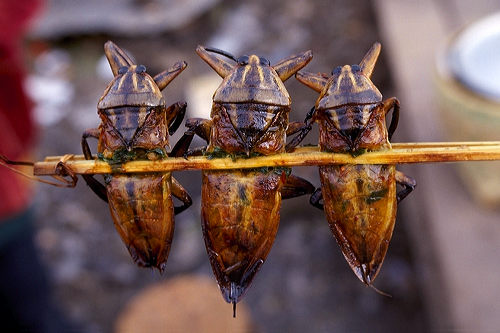
Posted on 10/21/2007 6:44:05 PM PDT by blam
How Amber Becomes Death Trap For Watery Creatures
ScienceDaily (Oct. 20, 2007) — Shiny amber jewelry and a mucky Florida swamp have given scientists a window into an ancient ecosystem that could be anywhere from 15 million to 130 million years old.
Scientists at the University of Florida and the Museum of Natural History in Berlin made the landmark discovery that prehistoric aquatic critters such as beetles and small crustaceans unwittingly swim into resin flowing down into the water from pine-like trees. Their findings are published in the Proceedings of the National Academy of Sciences.
The resin with its entombed inhabitants settled to the bottom of the swamp was covered by sediment and after millions of years became amber, a bejeweled version of the tar pits that trapped saber-toothed tigers in what is now California, said David Dilcher, a UF paleo-botanist and one of the study’s researchers.
“People never understood how freshwater algae and freshwater protozoans could be incorporated in amber because amber is considered to have been formed on land,” said Dilcher, who works at the Florida Museum of Natural History on the UF campus. “We showed that it just as well could be formed from resin exuded in watery swamp environments. Later the swamps may dry up and the resin hardens.”
Dilcher and Alexander Schmidt, a researcher at the Museum of Natural History in Berlin, replicated the prehistoric demise of the water bugs by taking a handsaw to a swamp on Dilcher’s property near Gainesville in north Central Florida. After they cut bark from some pine trees, the resin flowed into the water and they collected the goo and took it back to Dilcher’s lab on campus.
Stuck in the sticky sap were representatives of almost all the small inhabitants of the swamp ecosystem, Dilcher said. “We found beautiful examples of water beetles, mites, small crustaceans called ostracods, nematodes, and even fungi and bacteria living in the water,” he said.
The discovery not only solved the mystery of how swimming bugs could have been entombed in sticky sap from high up in a tree but could lead to new information about prehistoric, maybe even Jurassic, swamps, Dilcher said. Studying organisms that were trapped for millions of years in amber may help scientists to recreate prehistoric water ecosystems and learn how these life forms changed over time, he said.
While no one is claiming that the entombed bugs will be brought back to life through genetic splicing, the discovery may give clues about the evolution of microorganisms, he said.
“We all think of horses, elephants and people as having changed a great deal through time,” he said. “Have amoeba and other microscopic organisms changed much? Or have they found a niche or what we call a stasis in which their evolutionary lineage persists for many hundreds of millions of years? We don’t have the answers to those questions until we look at the fossil record.”
Insects such as bees, spiders, tics and fleas that become embedded in amber have received a great deal of attention because they are so abundant, Dilcher said. “Unfortunately, people have overlooked the little things while searching for the big bugs and the flowers in amber,” he said.
Microorganisms are important because they form relationships with higher organisms, making them the foundation of the pyramid of life, Dilcher said. “To understand more about their evolution adds an important step in our understanding of life itself,” he said.
Gene Kritsky, editor of the journal American Entomologist and a biology professor at the College of Mount St. Joseph in Cincinnati, said Dilcher has performed a great service in answering a question that has long puzzled scientists, the seemingly contradictory aspect of finding aquatic insects in tree resin.
“It’s been one of the strange things mentioned by biologists and entomologists for decades – how do you account for aquatic insects and organisms in what seemed to be an ancient terrestrial environment,” Kritsky said. “Dilcher examined this contradiction by creating the conditions that would cause sap deposits to flow into water to see what would happen. The results demonstrated that aquatic insects can be trapped in resin without leaving their aquatic world. Thus, the presence of aquatic organisms in amber is the result of a simple natural process.”
Adapted from materials provided by University of Florida.
GGG Ping.
So do they need an “Amber Alert”?
|
|
|||
Gods |
Thanks Blam. Have they found the nine princes yet? |
||
|
· Mirabilis · Texas AM Anthropology News · Yahoo Anthro & Archaeo · · History or Science & Nature Podcasts · Excerpt, or Link only? · cgk's list of ping lists · |
|||
replicated...? So, I wanna know who used the handsaw that caused the prehistoric demise of the waterbugs...
This is a cool article.... I love amber jewelry. ;-]

...and just how *big* are these waterbugs? Should we be scared?
ping a ling!
Sidebar about a missing (and now re-created) amber-based treasure:
http://en.wikipedia.org/wiki/Amber_Room
Working on it. Picture a cartoon; Two Tyrannosaurs -- one has just bitten a chunk out of the bark of a pine tree.
"Rxx, what the heck are you doing? We're supposed to be meat eaters, remember?"
"Relax, Srs. It's my life insurance program. I'm causing the production of amber, which will entrap insects that have bitten us. Millions of years from now, idiotic monkey creatures will find a way to resurrect us, and we will thank them by eating them!"
"You've been reading that claptrap Science Fiction again, haven't you? Is that the same guy who keeps trying to scare us about an invader from outer space?"
"It won't do any harm. You can't be too careful, you know. Now, let's go eat the leg off something. My mouth is sticky."


Now listen to what Bobasuarus is trying to tell you...one day, some silly monkey people are going to resurrect us and you will need to know how to get along in that new world. The first thing you must do is join Freerepublic and always donate to the quarterly Freepathons, got that? And never vote Democrat...
Must have lost something in the translation.
I’ve always believed it went down with the Wilhelm Gustloff when it sank with 7000 deaths near the end of the war.
sokay...I’ve got a raging fever, need to take my meds.

yum yum...large water bugs stuffed with herbs and basted with soy sauce, then roasted to perfection over charcoal.
I’ll pass. I’m allergic to frass. (By personal choice.)
“I’ve always believed it went down with the Wilhelm Gustloff when
it sank with 7000 deaths near the end of the war.”
Prompted by your post, I dug a bit.
“HOLY CR-P!”, I’d never heard of this sinking before.
That’s a mind-blower!
http://en.wikipedia.org/wiki/KdF_Ship_Wilhelm_Gustloff
http://www.wilhelmgustloff.com/
Mark
Disclaimer: Opinions posted on Free Republic are those of the individual posters and do not necessarily represent the opinion of Free Republic or its management. All materials posted herein are protected by copyright law and the exemption for fair use of copyrighted works.